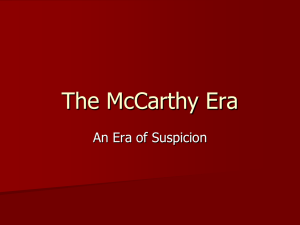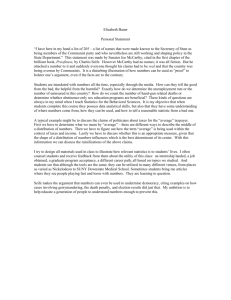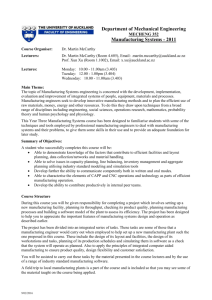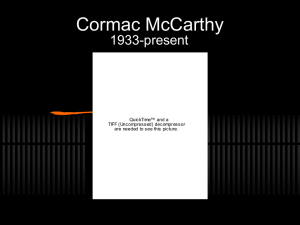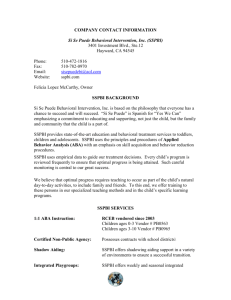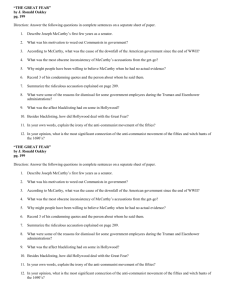Party Renegade: McCarthy's Effect on Republican
advertisement
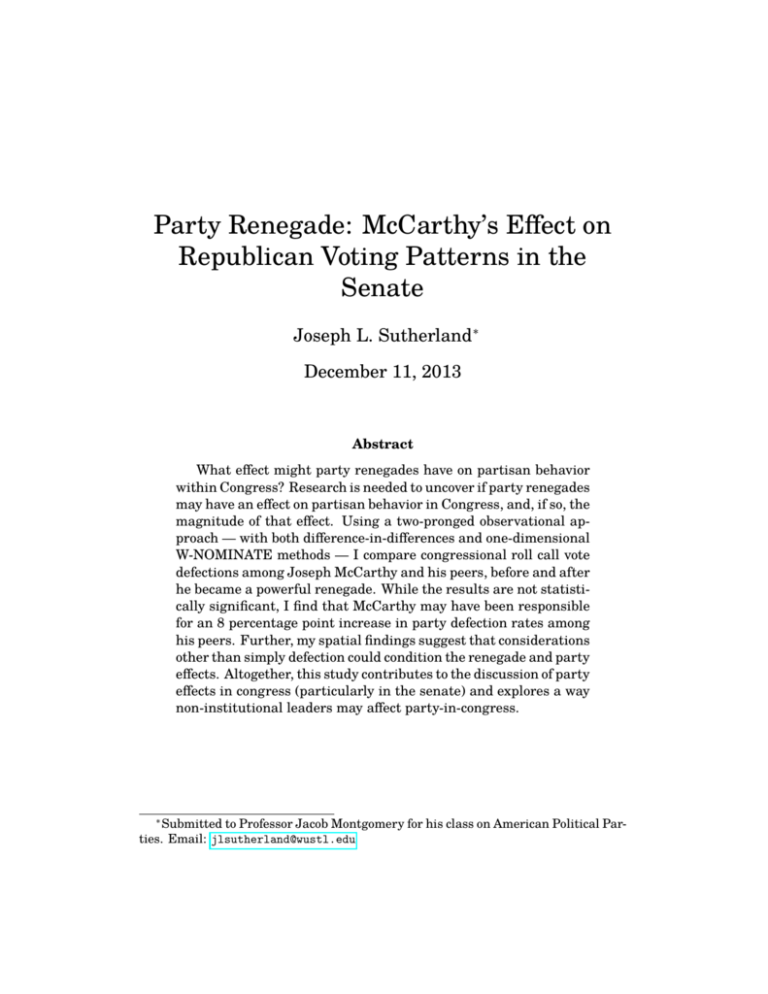
Party Renegade: McCarthy’s Effect on Republican Voting Patterns in the Senate Joseph L. Sutherland∗ December 11, 2013 Abstract What effect might party renegades have on partisan behavior within Congress? Research is needed to uncover if party renegades may have an effect on partisan behavior in Congress, and, if so, the magnitude of that effect. Using a two-pronged observational approach — with both difference-in-differences and one-dimensional W-NOMINATE methods — I compare congressional roll call vote defections among Joseph McCarthy and his peers, before and after he became a powerful renegade. While the results are not statistically significant, I find that McCarthy may have been responsible for an 8 percentage point increase in party defection rates among his peers. Further, my spatial findings suggest that considerations other than simply defection could condition the renegade and party effects. Altogether, this study contributes to the discussion of party effects in congress (particularly in the senate) and explores a way non-institutional leaders may affect party-in-congress. ∗ Submitted to Professor Jacob Montgomery for his class on American Political Parties. Email: jlsutherland@wustl.edu Introduction Twenty-two years after Senator Joseph McCarthy passed away, Rhode and Shepsle (1978) famously declared that political outcomes occur simply because political actors seek to realize their goals in a historical moment (Aldrich 2011). Broadly applied, this maxim has helped students of political science to explain the great deal of variance in behavior that occurs within Congress as a result of the party system. Scholars have examined legislative influence based on institutional rules that couple with parties (Rohde 1991; Aldrich 1993, 2011; Cox and McCubbins 1993) and pivots (Krehbiel 1993, 1998). However, political scientists have not yet applied this maxim to the study of party renegades— powerful legislators who derive their influence from phenomena other than the set of institutional rules. Research is needed to discover if party renegades may have an effect on partisan behavior in Congress, and, if so, the magnitude of that effect. Examination of this effect could contribute to our understanding of the variance in congressional party effects observed in a variety of issues. Senator McCarthy fits the bill: in retrospect, he was most certainly a party renegade. By exploiting the strong, salient fear of a domestic Communist threat, McCarthy “[came] far and [came] fast,” quickly becoming an influential leader of the Republican party merely four years after his election to the U.S. Senate in 1946 (Griffith 1970). A man precluded from institutional power at the time, McCarthy serves as a well-suited case with wish to examine the effect of renegades. We would expect McCarthy’s influence to cause his peer senators to act according to his preferences on pertinent roll call votes. Moreover, because his power grew overnight after he announced his “blacklist” of known American communists—four years after he entered Congress—we have the opportunity to study the change in his influence using panel methods. 1 I combine two observational methods to uncover an effect. First, I perform a difference-in-differences regression analysis on a data set of roll call votes gathered from (and coded by) VoteView.org that occurred among stayers in the U.S. Senate during the time McCarthy served as a senator. In particular, I examine the proportion of times each senator defects from the party majority when McCarthy defects from the party majority on both pertinent and all roll calls. Second, to hedge against the fact that a legislator’s party defection may be conditioned by factors other than co-defection, I execute a paired one-dimensional W-NOMINATE analysis on the set of votes to represent the spatial migration of the stayers on communism-related votes versus all votes. My findings are twofold. First, though an arithmetic difference-indifferences approach suggests that McCarthy’s actions were responsible for roughly an eight percentage point increase in defection on pertinent roll calls and roughly a five percentage point increase in defection on all roll calls, my ordinary least squares dummy models imply that the suggested effect is both insignificant and endogenous. Second, the paired W-NOMINATE comparison shows that on communism related roll calls, the Senators moved opposite the direction we would expect them to move if there was not a renegade effect. These W-NOMINATE findings complicate the conclusions drawn from the difference-in-differences analysis. Together, the findings demonstrate the problematic nature of the effect of party renegades on party legislative voting patterns—and, perhaps, why they have not been studied empirically to date. Still, this study contributes to the underrepresented literature on party effects in the Senate and the discussion of party mechanisms and power in Congress. Further research should focus on establishing causality finding more instances of party renegades to study. 2 Party Effects in Congress The traditional literature on Congressional power looks at power drawn from a set of institutional rules, both intra-party and within each House (Riker 1982, 1986; Shepsle 1979; Shepsle and Weingast 1987). These works discuss how in order to attain their fundamental political goals—whether that be satisfaction of ambition or achievement of policy preferences (Schlesinger 1966; Fenno 1973)—most legislators establish a reputation through committee assignments that is key to their legislative career (Bullock 1985; Cox and McCubbins 2007). With the tenets of this traditional approach in mind, most legislators seek to adhere to this “tried-and-true” path to influence in Congress (Dodd 1977). Supplementing the traditional corpus, the literature on party effects in Congress fleshes out how actors who achieve power through their political party can influence legislative institutions and behavior. Party leadership posts, committee chairs, and special rules (Shepsle 1993) comprise a major mechanism by which party elite can influence congressional behavior. However, scholars have discussed the extent to which party discipline and brand can condition congressional influence. Conditional party government (CPG) theory posits that ideologically homogeneous parties will achieve their preferences by transferring power to agenda-setting elites within Congress, such as the Speaker and Majority Leader (Rohde 1991; Aldrich 2006). Alternatively, cartel theory argues that parties aim to minimize member defection in order to ensure they can achieve their policy preferences (Cox and McCubbins 1993, 2007). Both CPG and cartel theory assume that the ultimate goal of party discipline and party brand is to achieve desired policy outcomes; they do not acknowledge the existence of “multiple goals” (Smith 2007). Thus, while they do a good job of explaining why parties may want to ensure members are disciplined and contributing properly to the brand, they 3 do not fully explain why members may want to deviate from the party plan.1 Further, CPG and cartel are hard-pressed to infer how parties may influence legislative behavior in the Senate; cartel theory’s focus on the Reed rules precludes it from making substantive predictions based on party in the Senate, while CPG simply claims not to have much to do with the Senate. Accordingly, the Senate has “fallen wayside in the contemporary congressional organization debate,” and could use additional research (Smith 2007). On the other hand, Krehbiel (1993, 1998) argues that party has nothing to do with legislative behavior. Instead, a set of “pivots,” in conjunction with supermajority preferences, determines legislator behavior and policy outcomes. Krehbiel’s work, though valuable in many ways, is limited by the fact that some party effects are discernible in his studies’ findings in the fact that legislative politics generate status quo points across the spectrum, rather than in just one place, as Krehbiel argues (Smith 2007). Furthermore, the argument that party does not have an effect is weakened by the fact that several studies have observed party effects in legislatures. Jenkins (1999) studies roll call votes in the nonpartisan confederate regime resultant of the American Civil War and finds that behavior is much more predictable when parties exist in a Congressional body. Masket (2007) studies W-NOMINATE models of the California legislature before and after it dispensed with cross-filing and finds that parties-as-organization coerce legislators into party-in-congress sects. Altogether, there is a strong case for the influence parties and their members can exert in Congress. 1 In cartel theory, Cox and McCubbins (2007) mention that a member’s willingness to follow elite action on party unity votes has a significant impact on whether she is assigned to her choice of committee. Since members desire choice assignments (Dodd and Oppenheimer 2012), we would expect them to fall in line with party elites’ preferences. 4 Party Renegades To date, political science has not discussed the part party renegades— powerful legislators who do not derive their influence by way of institutional rules—could play in conditioning the effect of party discipline, and thus party power (see section supra), in Congress. In fact, a great deal of unexplained variation in party influence on congressional activity has been observed in a variety of politically charged issues (Snyder and Groseclose 2000).2 While this variation could be explained simply by the salience of such issues at the given time,3 the presence of a party renegade linked to the issue at hand could be responsible. There are several reasons why we may observe in effect as a result of the party renegade. First, renegades may stoke pre-existing factionalism among partisans, causing them to vote contrary to the party on issues important to their faction. In a way, the defection of the party renegade could encourage other members to defect simply because they would no longer be the only one defecting. Second, renegades may send signals that the party’s leadership has weakened. If the party leadership is unable to keep renegades disciplined, the party brand and the party’s ability to achieve its policy preferences are at risk. Third, leaders afraid of losing influence may want to appease the renegade when they can. Thus, leaders would allow other members to vote against the party majority with less hesitance than they would if a renegade was nonexistent. In this sense, they are preserving their political capital— implying that the cost to the leader’s political capital of whipping a defector’s vote is greater. Forth, peer legislators afraid of losing influence 2 Snyder and Groseclose (2000) find that issues such as agriculture, nuclear power, energy policy, and public works have experienced dramatic changes in party influence over time. 3 See, e.g. Miller and Stokes (1963) and Rivers and Rose (1985) for discussion of issue salience as a possible conditioning factor. Indeed, public opinion is a significant determinant of policy change (Bartels 1991; Erikson, MacKuen, and Stimson 2002; Green, Palmquist, and Schickler 1998). 5 may defect with the renegade in order to appease the renegade when they can. In return, the renegade may support the legislator (with greater influence than said legislator possesses) in return. In many ways, this fourth route to influence resembles the log roll. These four reasons show that be may observe changes in voting behavior simply because of the phenomenon of defection. However, there are several more reasons why we may observe changes in voting behavior attributed to the content of the bill on which the renegade is defecting. For example, there may be exogenous conditions that lend power or salience to an issue in a way that changes the effect party can have on legislator behavior, similar to the increase in the Republican Party’s congressional influence after 9/11 because of their stance on national security (Hartog 2005). Further, one bill on communism, for example, may be “lighter” than another “heavier” bill which spends more money trying to curtail communist efforts—bringing budgetary issues into the fold. Conscience issues could also have a part to play. Altogether, these additional reasons suggest that we may observe changes in voting behavior because of an interaction between the renegades defection behavior in the content of the bill. Thus, there are two ways we may observe a party renegade affecting party behavior. First, when the renegade votes against the party majority, other party members may also defect from the party majority. Second, party members may change their spatial position on bills related to the renegade’s issue because of the renegade’s defection. Tail Gunner Joe: A Renegade in Congress Senator Joseph P. McCarthy was elected to Congress as the junior senator from Wisconsin in 1946. By 1952, Joe McCarthy had made his name synonymous with the issue of communism-in-government. He had become so strongly a leader of the Republican Party over those but 6 six years that the Republican platform within and outside of congress was being shaped by McCarthy and his supporters (Griffith 1970:189). Clearly, McCarthy was an influential leader. To boot, he had amassed his power in a relatively short amount of time. However, his history suggests that he did not gain this power within Congress through a set of institutional rules, as the traditional literature would expect. Indeed, party leaders did not reward McCarthy with preferred committee assignments: he was placed on the Senate Committee on Government Operations, putting him, in the words of Senate Majority Leader Robert Taft, “where he can’t do any harm” (Fried 1990). McCarthy was a renegade through and through: he derived his influence over the party-incongress from means other than the institutional set of rules. He used that influence to affect actions related to communism. If not through a set of institutional rules, how would McCarthy have gained his power? The social context in which Senator McCarthy served was rife with opportunity to exploit the popular fear of communism for personal preferment and power (Griffith 1970). To achieve the critical amount of popular support necessary to engender power, McCarthy chose the opportune mechanism: fear. McCarthy’s choice to attack communists was one of immense opportunity. As De Figueiredo and Weingast (1999) suggest, if beliefs about the probability of victimization reach a certain point, the average citizen will support a nationalist leader. By exploiting the fear that ordinary Americans, too, could have their lives ruined simply by the accusation of being communist — and by cueing the social identities of Americans who knew they were not communists, which were most Americans (Dickson and Sheve 2006) — McCarthy solidified his support. Thus, it is clear there was opportunity for McCarthy to cultivate power from means other than a set of institutional rules; without a doubt, he did. Thus, by definition, McCarthy was a renegade. Moreover, McCarthy’s 7 power grew overnight after he announced his “blacklist” of known American communists on February 1, 1950 in what is referred to as his “Wheeling Speech,” just four years after he entered Congress (Griffith 2007). Therefore, we are presented with, in a way, two Sen. McCarthys: one without any power, before the Wheeling speech, and one with power, after the Wheeling speech. Accordingly, it is possible that he conditioned the party effect in congress—and because we have the “two McCarthys,” it is possible to test this effect. To that end, the theoretical criteria discussed supra generate two falsifiable hypotheses with which we may examine the effect McCarthy had: Hypothesis 1: Among staying Republican senators (senators who are in Congress for the entire time period from 1946 to 1957), we will see an increase in defectors from the party majority on roll call votes were McCarthy defected, but only after The Wheeling speech.4 Hypothesis 2: Among staying Republican senators, the difference in spatial positioning of each senator before and after the Wheeling speech on the issue of communism will not be equal to the difference in the spatial positioning of each senator on all issues before and after the Wheeling speech. Methods and Data To test the two hypotheses, I collected data on Senate roll call votes with the aim of using well-established measures and replicable data. Therefore, the apparent choice was to use the data available from Poole and Rosenthal’s site, VoteView.org, and through their package wnomi4 It is important we only consider “stayers”, as their continued presence constitutes a control measure would not otherwise have if comparing whole congresses. 8 nate for the R statistics platform. I am thankful that they have made this data publicly available for my use. My sample included all roll call votes for the 80th through 85th Congresses (spanning from 1947 to 1958, book ending Senator Joseph McCarthy’s tenure). My first task was to determine which Republican (observing an effect only among co-partisans) senators served throughout the entire six congresses. By hand, I went through to find the 20, including McCarthy, to classify as “stayers.” I wrote an R script to parse out data for only these 20 senators. Next, I used Poole and Rosenthal’s VoteView software for Windows to find the bills categorized as relating to communism (“pertinent bills”) as per the Poole and Rosenthal designation.5 Then, I subset information on the 20 senators down to the pertinent bills and bills during the time period up until McCarthy stopped serving (April 1957). I then had two data sets, one for all bills and one for pertinent bills. For each of these data sets, I further subsetted them down to “before list” (February 1, 1950) and “after list”. Therefore, there were two data sets, and within each data set, two factor columns: period, coded as zero or one for before and after the list; mccarthy, coded as Y or N for voted with their against the party majority. To perform the difference-in-differences analysis, I needed to figure out when McCarthy voted against the party majority and when other senators joined him. So, developed a formula to determine when these conditions were met, by bill. I then calculated each senator’s defection rate as the proportion of the number of times the senator voted against the party majority to the total number of times the senator voted, by McCarthy vote (with or against party majority). To calculate the arithmetic difference-in-differences, I used the formula (d −b)−(c − a), where a is the mean of defect when mccarthy is N and period is 0, b is the 5 See their website for further detail on the classification of bills. 9 mean of defect when mccarthy is N and period is 1, c is the mean of defect when mccarthy is Y and period is 0, and d is the mean of defect when mccarthy is Y and period is 1. I used this same formula for both the pertinent bills and all bills. Furthermore, I performed an ordinary least squares dummy variable regression to examine the validity of this arithmetic result. The regression used defect as the response variable, and mccarthy, period, and mccarthy*period as the indicator variables, where mccarthy*period is the interaction term. To run the one-dimensional W-NOMINATE, I used the wnominate R package to determine the spatial coordinates of each senator by period and mccarthy (bills were already coded for spatial information via Poole and Rosenthal). Findings The arithmetic findings for the difference-in-differences analysis suggest that, for pertinent bills, the treatment effect is −0.08 percentage points in defection rate. Further, the analysis suggests that, for all bills, the treatment effect is −0.05 percentage points in defection rate. Table 1: Difference-in-Differences (Communism) McCarthy with Majority McCarthy against Majority 10 Before List After List 0.24 0.29 0.23 0.38 Table 2: Difference-in-Differences (All) McCarthy with Majority McCarthy against Majority Before List After List 0.25 0.34 0.26 0.38 Though these preliminary findings would seem to reject hypothesis one, a simple comparison of means is not enough to establish statistical significance. To account for this, Table 3 displays the results from the regression (mentioned above, and methods) for both pertinent bills and all bills. The regression results provide a clearer picture. We can see the coefficients for the interaction terms are equal to the arithmetic calculations, which bolsters the validity of the model. Interestingly, the only term significantly related to defection is mccarthy, which indicates whether he defected or not. From the table, it appears that if McCarthy defects, the defection rate increases by 14 percentage points—across both time periods. Therefore, it is possible that there is an endogenous effect in the model: McCarthy’s decision to defect could be a result of other members’ decisions to defect. Alternatively, another factor could cause them all to defect. Clearly, however, others are not defecting significantly because of him; the interaction term would detect this. Even though the R-squared terms are on the low-end, I am willing to accept the evidence from tables 1 through 3 as mild support of hypothesis one, the hypothesis that defection by McCarthy (after the list) would cause other members to defect. Now, to complicate things. Regarding the one-dimensional paired W-NOMINATE analysis, I found that the Senators shifted by an average of 0.17 (from before to after the list) on communism bills, while they shifted by an average −0.21 on all bills (including communism bills). While it is problematic to infer that these two scores are directly com11 Table 3: OLS Dummy Variable Regression Results Dependent variable: defect.communism defect.all (1) (2) period 0.011 (0.049) 0.140∗∗∗ (0.049) mccarthy mccarthy*period 0.083 (0.069) period 0.013 (0.036) 0.135∗∗∗ (0.036) mccarthy mccarthy*period 0.057 (0.051) Constant 0.242∗∗∗ (0.035) 0.247∗∗∗ (0.025) Observations R2 Adjusted R2 Residual Std. Error (df = 72) F Statistic (df = 3; 72) 76 0.140 0.105 0.151 3.921∗∗ 76 0.210 0.177 0.111 6.363∗∗∗ ∗ Note: 12 p<0.1; ∗∗ p<0.05; ∗∗∗ p<0.01 parable, we can at least discuss the signing. We would expect both signs to be the same if there were another factor at play. However, the signs are opposite. Therefore, we must infer that there is a factor conditioning the spatial movement of these bills, specifically when it comes to communism. This finding would push us to reject the null hypothesis for hypothesis two, confirming hypothesis two. Discussion On the whole, there are several limitations that prove problematic for the findings in this study. First, the sample size of the data used was not overwhelmingly large. With a sample size based on 20 senators, one of which had to be omitted because he was McCarthy, it is possible that the regression could underestimate the significance of the effect. Second, the coding scheme from Poole and Rosenthal lends itself to a wide definition of communism-related bills. There are a few bill observations that include agricultural considerations in conjunction with communism-related considerations. This wide definition could lend itself to an underestimation of the effect size in the regression, as well as a mis-estimation for the spatial migration for which I have no a priori expectations. Concerning the model, it seems the biggest issues are possible endogeneity and the possible presence of some latent relationship(s). The model is not robust against either of these; in fact, for the model to be valid, we must assume that all contributing variables are included. This is not the case. This endogenous relationship could be explored further experimental studies to tease out the true relationship between party renegades and party congressional behavior. In fact, it could be the case that change occurring within Congress with regards to communism occurred because public opinion willed it to be changed, and 13 not because Joseph McCarthy will to be changed. In other words, the issue could simply have been very salient.6 Moreover, the difference-in-differences OLSDV analysis provided results that were not statistically significant. Unfortunately, no more statistical power is available to us, as McCarthy served only for these six congresses. Perhaps another party renegade may exist within Congress— one with a longer tenure, and thus, a larger sample size of local votes from which to infer the effect a renegade may have. The fact that we were not able to substantively accept hypothesis one but could accept hypothesis two is somewhat troubling to me. This would lead us to believe that either the model is flawed (of which there is a high likelihood), the data is flawed (low likelihood), or what I was attempting to measure with the one-dimensional W-NOMINATE analysis was not what I did measure—though I believe the analysis was executed correctly. of course, the biggest shortcoming of interpreting the W-NOMINATE scores is that they are not directly comparable.7 The findings supplement the literature in several ways. First, the study introduces the idea of renegades. The theory behind renegades is strong enough positive results could still be observed in another case. Second, the study introduces renegades as a possible explanatory variable for the variance in the degree to which the party effect is conditioned on certain issues. Third, the study examines party effects within the Senate; any contribution is a good contribution to this underrepresented literature. Unfortunately, a lack of statistically significant results makes me hard-pressed to claim that these findings contribute, more generally, to our understanding of party effects in congress. How6 Salience hypotheses in relation to change within congress are discussed in footnotes 2 and 3, supra page 4. 7 Further, the laws of spatial voting theory dictate that each congress presents a new version of each senator. I bent this rule slightly, establishing a new version of each senator by condition and not by congress. 14 ever, if the results were significant, we would be able to conclude that institutional rules are not the only mechanism by which partisan actors may influence congressional outcomes. Future research should focus on accounting for the endogeneity and spurious contributor issues, possibly through an experiment or more indepth investigation (i.e. interviews). With a body of work such as this, we would be well on our way to understanding the effect renegades may have on party behavior in Congress. 15 Appendix Figure 1: Defection Rates on Pertinent Bills Before and After McCarthy’s Rise to Power (Difference in Differences) 16 Figure 2: Defection Rates on All Bills Before and After McCarthy’s Rise to Power (Difference in Differences) 17 References Aldrich, John H. 1993. Rational Choice and Turnout. American Journal of Political Science, 37(1), 246. Aldrich, John H. 2011. Why parties?: a second look. Chicago: University of Chicago Press. Asher, Herbert B. 1973. The Learning of Legislative Norms. The American Political Science Review, 67(2), 499. Bartels, Larry M. 1991a. Constituency Opinion and Congressional Policy Making: The Reagan Defense Build Up. The American Political Science Review, 85(2), 457. Bartels, Larry M. 1991b. Constituency Opinion and Congressional Policy Making: The Reagan Defense Build Up. The American Political Science Review, 85(2), 457. Bayley, Edwin R. 1981. Joe McCarthy and the Press. Univ of Wisconsin Press. Bullock, Charles S. 1976. Motivations for U. S. Congressional Committee Preferences: Freshmen of the 92nd Congress. Legislative Studies Quarterly, 1(2), 201. Bullock, Charles S. 1985. U.S. Senate Committee Assignments: Preferences, Motivations, and Success. American Journal of Political Science, 29(4), 789. Cox, Gary W, & McCubbins, Mathew D. 1993. Legislative leviathan: party government in the House. Cambridge; New York: Cambridge University Press. 18 Cox, Gary W, & McCubbins, Mathew D. 2007. Legislative leviathan: party government in the House. Cambridge; New York: Cambridge University Press. de Figueiredo Jr, Rui JP, & Weingast, Barry R. 1997. Rationality of fear: political opportunism and ethnic conflict. Military Intervention in Civil Wars. Dickson, Eric S., & Scheve, Kenneth. 2006. Social Identity, Political Speech, and Electoral Competition. Journal of Theoretical Politics, 18(1), 5–39. Dodd, Lawrence C. 1977. Congress and the Quest for Power. In: Congress Reconsidered, vol. 1. Washington, DC: CQ Press. Dodd, Lawrence C., & Oppenheimer, Bruce I. 2012. Congress Reconsidered, 10th Edition. CQ Press. Erikson, Robert S., Mackuen, Michael B., & Stimson, James A. 2002. The Macro Polity. Cambridge University Press. Fenno, Richard F. 1973. Congressmen in committees. Little, Brown. Fried, Richard M. 1990. Nightmare in Red : The McCarthy Era in Perspective: The McCarthy Era in Perspective. Oxford University Press. Green, Donald, Palmquist, Bradley, & Schickler, Eric. 1998. Macropartisanship: A Replication and Critique. The American Political Science Review, 92(4), 883. Griffith, Robert, & American Council of Learned Societies. 1987. The politics of fear. Amherst: University of Massachusetts Press. Jenkins, Jeffery A. 1999. Examining the Bonding Effects of Party: A Comparative Analysis of Roll-Call Voting in the U.S. and Confederate Houses. American Journal of Political Science, 43(4), 1144. 19 Krehbiel, Keith. 1998. Pivotal Politics: A Theory of U.S. Lawmaking. University of Chicago Press. Latham, Earl. 1965. The Meaning of McCarthyism. Masket, Seth E. 2007. It Takes an Outsider: Extralegislative Organization and Partisanship in the California Assembly, 1849–2006. American Journal of Political Science, 51(3), 482–497. Miller, Warren E., & Stokes, Donald E. 2012. Constituency Influence in Congress. American Political Science Review, 57(01), 45–56. Riker, William H. 1982. The Two-Party System and Duverger’s Law: An Essay on the History of Political Science. The American Political Science Review, 76(4), 753. Rivers, Douglas, & Rose, Nancy L. 1985. Passing the President’s Program: Public Opinion and Presidential Influence in Congress. American Journal of Political Science, 29(2), 183. Rohde, David W. 1979. Risk-Bearing and Progressive Ambition: The Case of Members of the United States House of Representatives. American Journal of Political Science, 23(1), 1. Rohde, David W. 1991. Parties and leaders in the postreform house. Chicago: University of Chicago Press. Schlesinger, Joseph A. 1966. Ambition and Politics: Political Careers in the United States. Rand MacNally. Shepsle, Kenneth A. Institutional Arrangements and Equilibrium in Multidimensional Voting Models. American Journal of Political Science, 23(1), 27. 20 Shepsle, Kenneth A., & Weingast, Barry R. 1987. The Institutional Foundations of Committee Power. The American Political Science Review, 81(1), 85. Smith. Party Influence in Congress. Cambridge University Press. Snyder, James M., & Groseclose, Tim. 2000. Estimating Party Influence in Congressional Roll-Call Voting. American Journal of Political Science, 44(2), 193. Wattenberg, Martin P. 1984. The decline of American political parties, 1952-1980. Harvard University Press. Wattenberg, Martin P. 1998. The Decline of American Political Parties, 1952-1996. Harvard University Press. 21
